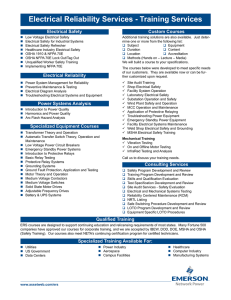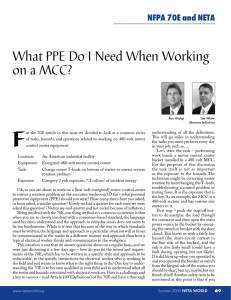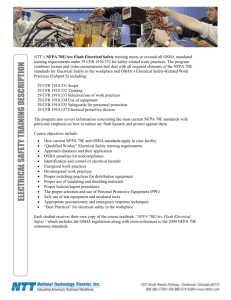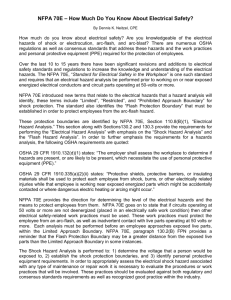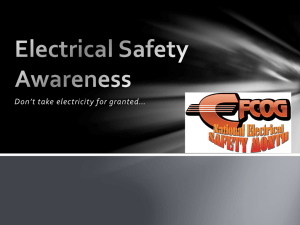NFPA 70E CONTRACTOR RESPONSIBILITIES
advertisement
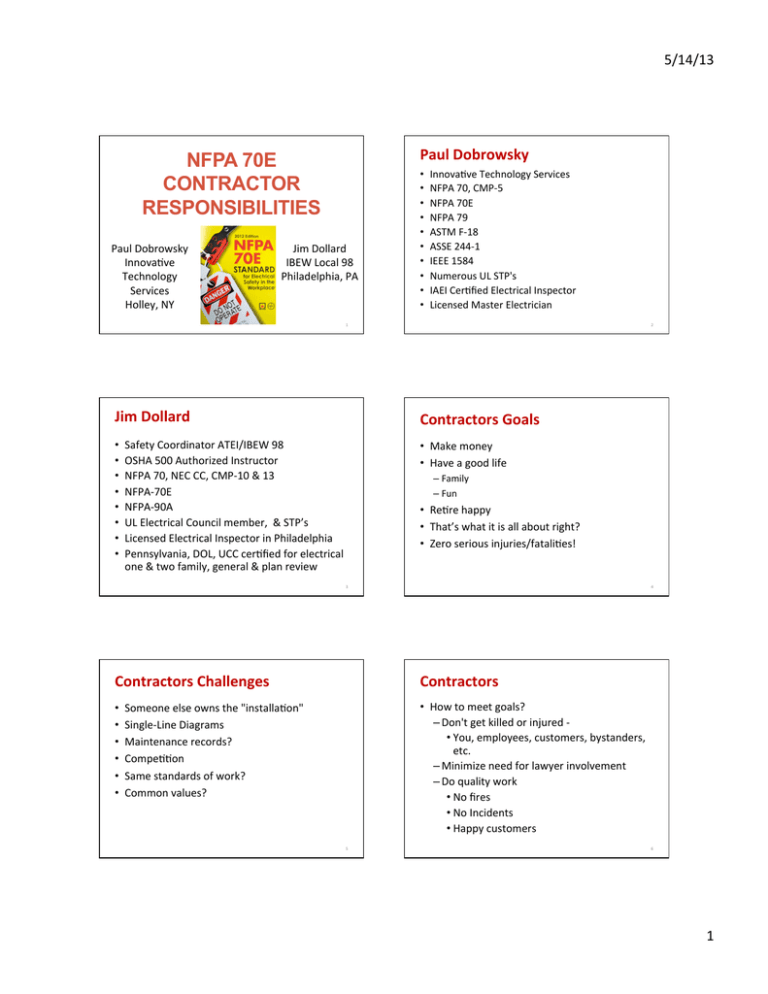
5/14/13 Paul Dobrowsky NFPA 70E CONTRACTOR RESPONSIBILITIES Paul Dobrowsky Innova6ve Technology Services Holley, NY Jim Dollard IBEW Local 98 Philadelphia, PA • • • • • • • • • • Innova6ve Technology Services NFPA 70, CMP-­‐5 NFPA 70E NFPA 79 ASTM F-­‐18 ASSE 244-­‐1 IEEE 1584 Numerous UL STP's IAEI Cer6fied Electrical Inspector Licensed Master Electrician 1 Jim Dollard • • • • • • • • 2 Contractors Goals Safety Coordinator ATEI/IBEW 98 OSHA 500 Authorized Instructor NFPA 70, NEC CC, CMP-­‐10 & 13 NFPA-­‐70E NFPA-­‐90A UL Electrical Council member, & STP’s Licensed Electrical Inspector in Philadelphia Pennsylvania, DOL, UCC cer6fied for electrical one & two family, general & plan review • Make money • Have a good life – Family – Fun • Re6re happy • That’s what it is all about right? • Zero serious injuries/fatali6es! 3 Contractors Challenges • • • • • • 4 Contractors • How to meet goals? – Don't get killed or injured -­‐ • You, employees, customers, bystanders, etc. – Minimize need for lawyer involvement – Do quality work • No fires • No Incidents • Happy customers Someone else owns the "installa6on" Single-­‐Line Diagrams Maintenance records? Compe66on Same standards of work? Common values? 5 6 1 5/14/13 Recommenda;ons Where do we Start? • Have an effec6ve Electrical Safety Program • What is NFPA 70E? • NFPA 70E is the “Standard for Electrical Safety in the Workplace” • Electrical Safety in the Workplace! • Foreword, page 70E-­‐1 • 70E formed to “assist OSHA” • New standard tailored to “fulfill OSHA responsibili6es” • Designed to be “fully consistent with the NEC” – Qualified workers – Training – Principles – Controls – Procedures – Job briefings – Audi6ng 7 8 NFPA 70E How Do We Get Safe Workplaces? • NFPA 70E is a consensus based standard, anyone can propose revisions • Not typically adopted by ci6es, municipali6es, or states similar to the NEC • OSHA focuses on their own requirements • OSHA plays a role in the development of NFPA 70E • NFPA 70E is recognized as the “Industry Standard” for electrical safe work prac6ces • Electrical Safety in the workplace is achieved through: – Installa6on Requirements, NEC – Safe Work Prac6ces, NFPA 70E – Proper maintenance • The electrical installa6on code, the NEC is formally adopted • Electrical inspec6ons are usually mandated by governmental bodies to enforce the NEC 9 What are the EC Responsibili;es? 10 OSHA Requirements • Follow all occupa6onal safety and Health requirements • Federal OSHA • State run occupa6onal safety and health plans • OSHA is the shall [Law] • 70E shows you how 11 • At a minimum: • 1926.21, 1910.332 Safety training and educa6on • 1926 Subpart K • 1926.416 Protect employees • 1910.333 Selec6on and use of work prac6ces • 1926.417, 1910.147, 1910.333(b)(2) LOTO • 1926.95, 1910.137, 1910.335 PPE & Electrical protec6ve devices • 1910 Subpart S 12 2 5/14/13 NFPA 70E NFPA 70E EC Requirements • Why adopt and implement the requirements in NFPA 70E? • Meet OSHA requirements • Remember, 70E drives OSHA requirements • Who mandates adop6on of 70E? • Who adopts 70E? • Who enforces 70E? • Understand the Purpose & Scope of the standard • ...provide a prac6cal safe working area for employees rela6ve to the hazards arising from the use of electricity – installa6on, inspec6on, opera6on, maintenance, demoli6on & other work ac6vi6es • Standard arrangement in 90.3 • 90.5 mandatory, permissive and informa6onal • Ar6cle 100 Defini6ons 13 14 Applica;on EC Responsibili;es • Ar6cle 105, administra6ve • 105.3 Responsibility – The employer shall provide the safety-­‐ related work prac6ces and shall train the employee – The employee shall implement the safety-­‐ related work prac6ces • 110.1(B) Contract Employer Responsibili6es – Instruct employees in any hazards communicated by host employer – Follow 70E work prac6ces and any addi6onal requirements of host employer – Advise host employer of unique hazards, unan6cipated hazards found and measures taken to correct and prevent reoccurrence • Documented mee6ng with host employer 15 16 Training Requirements Training Requirements • 110.2 Training Requirements – Employees who face a risk not reduced by installa6on requirements – Understand specific hazards – Safety related work prac6ces – Procedural requirements – Iden6fy and understand the rela6onship between electrical hazards and possible injury • Training can be classroom, on-­‐the-­‐job or a combina6on – Degree of training based on risk to employee • Emergency procedures, employees exposed to shock and those responsible for taking ac6on – Methods of release, – First aid, resuscita6on, CPR, AED -­‐ if warranted • documented annually 17 18 3 5/14/13 Training Requirements • Qualified person training • Ar6cle 100 • Qualified Person. One who has skills and knowledge related to the construc6on and opera6on of the electrical equipment and installa6ons and has received safety training to recognize and avoid the hazards involved. 19 20 Training Requirements Training Requirements • Qualified persons must also be familiar with: • Qualified persons permiqed inside the LAB must also be trained in: – precau6onary techniques – PPE – Insula6ng/shielding material & tools – Test equipment – Skills/techniques to iden6fy energized conductors and circuit parts – Skills/techniques to iden6fy nominal voltage – Approach distances – Decision making process to determine degree and extent of hazard and necessary PPE • A employee can be qualified for some equipment or tasks and not others • Tasks performed less than once a year require retraining • How? 21 22 Training Requirements Training Requirements • Qualified persons must also be trained to select appropriate voltage detectors – Demonstrate use, absence of voltage and other indica6ons – Understand limita6ons of voltage detector • Employer must determine that employees are complying with NFPA 70E – Regular supervision, or – Inspec6ons – On an annual basis • Unqualified persons – Any necessary work prac6ces • Retraining – Where employees are out of compliance – New technology, equipment or procedures – Work prac6ces not normally used • EC must document each employee has received this training – When employee demonstrates proficiency – Maintained throughout employment 24 – Content, names, dates 23 4 5/14/13 Electrical Safety Program (ESP) Electrical Safety Program (ESP) • 110.3 -­‐ See Annex E • Include ESP Hazard iden6fica6on and risk assessment procedure for work within limited approach and arc flash boundaries – IN ANSI/AIHA Z10 Standard for Occupa6onal Safety and Health management Systems – EC must implement and document ESP that directs ac6vity appropriate for electrical hazards, voltages and energy – Awareness and self discipline of employees – Iden6fy ESP Principles – Iden6fy ESP Controls – Iden6fy ESP Procedures for work within limited approach and arc flash boundaries – To iden6fy hazards, assess risks & mi6ga6on strategies • Job Briefing -­‐ Employee in charge – Each energized task, hazards, precau6ons, source, controls, PPE – Repe66ve/similar tasks, one briefing per day – Rou6ne work, brief discussion – Energized Electrical Work Permit Informa6on 25 26 Audi;ng Use of Equipment • ESP Electrical safety audi6ng – Audit ESP at least once every three years – Audit field work to verify compliance with ESP, foreman, permits issued, jobs completed – All audi6ng must be documented by the EC, just build it into the ESP • Compliance with 110.4 requires: • Only qualified persons • Appropriate [Rated] testers/meters – Monitor employee owned testers/meters • Train in compliance with 110.2 27 Use of Equipment 28 Underground Lines and Equipment • Train in portable electrical equipment – Extension cords – Handling of cords, tools – EGC connec6ons, cord caps etc. – Inspect before each use – Defec6ve Equipment – Conduc6ve work loca6ons, consider baqery powered tools or other types • Before excava6ng – contact owners or authori6es to locate and mark – call before dig • Evaluate if reasonable possibility exists of contac6ng -­‐ use safe work prac6ces • GFCI requirements • OCPD modifica6on -­‐ not permiqed 29 30 5 5/14/13 Establishing an Electrically Safe Work Condi;on (ESWC) Establishing an Electrically Safe Work Condi;on (ESWC) • Ar6cle 120 • Crea6ng an ESWC – Establish the process • Develop wriqen LOTO program -­‐ including procedures • Use Ar6cle 120, 1910.333(b)(2), 1910.147 • 120.1 -­‐ 6 step process – determine sources – interrupt load current -­‐ open disconnect – verify isola6on -­‐ if possible – apply LOTO devices -­‐ per policy – verify deenergiza6on -­‐ check-­‐test-­‐check – apply temporary protec6ve grounding equipment if appropriate • Train in verifica6on of an ESWC in 120.1 • Most importantly, train your LOTO program! 31 Establishing an Electrically Safe Work Condi;on (ESWC) 32 Work Involving Electrical Hazards • Ar6cle 130 -­‐all applies • ESWC general rule, training and in ESP • Jus6fica6on, addressed in training and in ESP – Greater Hazard – Infeasibility – Less than 50 volts • Energized work permit -­‐ wriqen – When required – Elements of your permit – Exemp6ons • Temporary protec6ve grounding equipment – Placement – Capacity – Approval ASTM F855 – Low impedance 33 Working Exposed to Electrical Hazards 34 Equipment Labeling • Field marking -­‐ Equip. such as Switchboards, panelboards, industrial control panels, meter socket enclosures & MCC's -­‐ examined, adjusted, serviced or maintained energized • Shock Hazards – Shock approach boundaries • Limited • Restricted • Prohibited – Qualified vs. Unqualified • Arc Flash Hazard Analysis – Incident energy analysis -­‐ document exposure – HRC Tables, limited to parameters – At least one of: • Incident energy & working distance • Maximum clothing Arc Ra6ng • Highest HRC for equipment – Nominal system voltage – Arc flash boundary • Method documented 35 36 6 5/14/13 Personal and Other Protec;ve Equipment Other Precau;ons • Shock • Arc Flash • Alertness – When hazardous – When impaired – Changes in scope • Blind reaching • Illumina6on, Conduc6ve ar6cles & materials • Doors, hinged panels, Housekeeping • Flammables, An6cipa6ng Failure • Rou6ne opening/closing of circuits • Reclosing ater OCPD opening – all parts of the body inside AFB – burns should be survivable • • • • • Layering Clothing materials, permiqed, not permiqed PPE care and maintenance PPE standards Overhead lines 37 38 Chapter 2 Safety-­‐Related Maintenance Requirements Chapter 2 Safety-­‐Related Maintenance Requirements • Training in maintenance procedures & tests • Single-­‐Line Diagrams -­‐ kept current • Follow manufacturers maintenance instruc6ons or industry standards • Maintain OPD -­‐ document maintenance, tests & inspec6ons • General maintenance -­‐ proper condi6on • Flexible cords -­‐ avoid strain & damage – Substa6ons, Switchgear, Switchboards, Panelboards, MCC's, Disconnect Switches – Premises Wiring – Controller Equip. – Fuses and Circuit Breakers – Rota6ng Equipment – Hazardous (Classified) Loca6ons – Baqeries and Baqery Rooms – Portable Electric Tools and Equipment – Personal Safety and Protec6ve Equipment 39 Chapter 3 Safety Requirements for Special Equipment • • • • • 40 Thank You Electroly6c Cells Baqeries and Baqery Rooms Lasers Power Electronic Equipment Research & Development Laboratories Ques+ons ? 41 42 7
